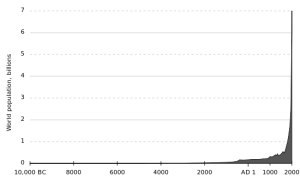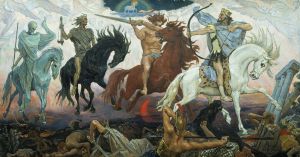This is the last of a three-part series on contraception and women’s health, social well being, and the environment.
The most serious threat to life on Earth is the human population, which has recently surpassed seven billion. SEVEN BILLION. 7,000,000,000. That’s a number the human mind cannot even wrap itself around, although we are physically able to write the digits for it. When I was born, the population was about two billion. It surpassed three billion the year after I graduated from college. And it has been rising steadily since.
When most forecasters of doom and gloom look at potential global disasters, they tend to focus on resource depletion and global warming, or on global war and nuclear disaster. But none of these prospective disasters would be nearly as likely if the world’s human population had stabilized at around one billion. Why was the population at or below a billion for so long? Because the birth rate did not exceed the death rate by much, even after the agricultural revolution some ten thousand years ago.
The major causes of death prior to the nineteenth century were disease, malnutrition and childbirth. During the nineteenth and twentieth centuries, these threats to human life were tackled and largely conquered, with the consequence that the human population has since exploded, straining the very resources that sustain us. Malthus, who lived at the turn of the nineteenth century, foresaw this population crisis, which he predicted would bring about global human collapse, called the Malthusian catastrophe. His predictions were eerily similar to the four horsemen of the apocalypse:
- conquest (also translated as defeat, destruction, or pestilence),
- war,
- famine, and
- death.
Several human inventions and interventions of the past century have staved off this apocalypse—increased agricultural yield with modern farming and fertilizers; the growth of cities that absorb population vertically rather than horizontally, and medical interventions that limit disease in such highly crowded populations. It seems obvious, however, that the best solution to a Malthusian catastrophe would be to reduce the population—birth control freely available to every woman (and man) on Earth.
Four items listed prominently in a Wikipedia article on potential Global Catastrophe are:
- warfare and mass destruction,
- global warming,
- ecological disaster, and
- world population and agricultural crisis.
All of these potential catastrophes threaten the biosphere because of excess human population–more humans in a given area than its resources can sustain. Humans may have wiped out as much as a quarter of the species of land mammals by hunting and environmental destruction. More recently, the human plague has taken the form of pesticides, atmospheric toxins, and pollutants that are poisoning insects (and their bird predators), elevating the global temperature, and displacing species from their natural habitat. Collectively this Earth-altering, human activity has defined what some scientists term the Anthropocene epoch.
It is no surprise that a prevalent contemporary literary genre is the dystopian novel (e.g., Cloud Atlas) and that movies on the theme of environmental collapse are common current fare in cinemas (e.g., Interstellar). Moreover, a common exercise of many contemporary futurists is to estimate the year when the earth will no longer be habitable and the human population will collapse.[1] These writers and artists are the prophets of our time, and they are shouting, “Repent!” But, like prophets of old, they are also largely ignored, and the problems they call out are rationalized by those in power.
So now, the population of this planet is nearly four times what it was when I was born. At that time, we were in the middle of the Great Depression, when everything was scarce and the poor were suffering, as they always do. We were considered poor by our neighbors—we had no running water in the house and had heat only from a wood-burning kitchen stove during those fierce Michigan winters. And my mother had more babies than they could afford or at least than my father wanted; birth control—such as it was—was unreliable at best.
One family in the neighborhood seemed to have enough of everything, and more. The boy had lots of toys and they ate well, and the family even threw food away. I remember wondering as a child if there were enough food in the world for me, and if I should even be alive. I had a little chant for those times when I felt deprived. “There must be enough in this world for me. Look at all that others waste.”
Jesus declared that “The poor ye will always have with you,” and those with means should “Give alms to the poor,” Jesus, as far as we know, had no children of his own. In this spirit, the best gift one could give to the poor, and especially to poor women, would be the means of reliable contraception. Childbirth has always been a major cause of death in impoverished women. Having too many children perpetuates the cycle of poverty and adds to the human destruction of our sustaining mother, Earth.
So, overpopulation could be considered equivalent to matricide. Pope Francis,[2] are you listening? Change that old, ill-advised doctrine of the Catholic Church. Too many children–this is the TRUE plight of the poor, and of the earth itself. Let us save our mothers by offering:
CONTRACEPTION TO ALL.
(And to all a good night. And a wonderful holiday)
[1] When I was young, futurists were looking at bright, shiny, exciting futures because they had no idea that resources could become so quickly limited, nor that this shiny future would exact such an environmental cost.
[2] You are my favorite pope. Take this one last step to sainthood and eliminate the church’s doctrine against contraception.



Well reasoned post, Joanne. One reason we chose not to have kids is that I didn’t want to bring them into a world already bulging at its seams.
Thanks for the comment, Nancy. I had three, but two of them were “unintentional” although much loved when they arrived. If everyone had access to birth control, there would still be a few unintended pregnancies, but the population would level off and eventually decrease. Don’t know how much time we still have.
Interesting post, not sure I agree with everything but like another commenter said, “well reasoned”. One factor that could be considered, “nuclear power” it may seem insignificant but the timing of the two events are noteworthy. If it weren’t for the harnessing of the atom wars would be easier waged (what would contain them). Contraception inhibits life, the other one destroys both of which if we believe in a loving God know it doesn’t come from him. I’m not sure we should try to inhibit life but learn to be responsible caring beings to which should be our ultimate goal.
I enjoyed your article. I have consciously chosen not to have kids in this life. Even when I was a child, I worried about poverty around the world, starving children, and overpopulation, not to mention human trafficking. I wish more people would adopt kids.
Thanks, Tricia. And good for you!